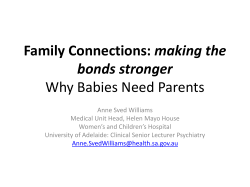
RAPPT-Scoring-Tool-2015
Source: Ludington-‐Hoe SM, Morgan, K. & Morrison-‐ Wilford, B. (2015). Minimizing risk of newborn death: The Revised RAPPT Scoring System. The Learner’s Manual for Kangaroo Care Certification . Cleveland, OH: United States Institute for Kangaroo Care Revised RAPPT™ Infant Assessment Scoring Tool Sign Respiratory Apneic Activity non-‐responsive 1 grunting / flaring/ retracting /tachypneic crying &/or active motion Position nares &/or mouth or fully occluded or not visible; &/or neck fully extended or flexed pale, dusky flaccid extremities no recoil nares or mouth partially occluded or partially visible; &/or neck partially extended or flexed acrocyanosis extremities partially flexed; slow recoil Perfusion Tone 0 2 Easy, no distress Quiet Alert, sleeping or breastfeeding nares and mouth uncovered and visible; neck midline pink all over Extremities fully flexed; swift recoil Time Of Birth_____ Time into KC_____ Respiratory Activity Position Perfusion Tone *Total Score RN Action was: Reposition head / neck Uncover nares / mouth Incline mother Continue skin-‐ to-‐skin/KC Stop Skin-‐to-‐ skin/KC Move to radiant warmer/crib Call Neo/Peds Time KC ends Duration of KC RN initials K Morgan © Revised 2015 Use of Tool and Interpretation of the RAPPT™ Score for Skin-‐to-‐Skin Contact/Kangaroo Care Prior to delivery, review mother’s chart & identify antepartum SUPC risk factors (Table on reverse). Any risk factor indicates continuous monitoring with documentation every five minutes. • Document time of birth on RAPPT™ score sheet • Document time into SSC/KC (should be immediately [within 1-3 minutes] after delivery, but may occur later) • Score infant immediately after placed into SSC/KC (0,1 or 2) in each field. *Total score 0 - 10 • Frequency of RAPPT™ scoring should be continuous, with documentation every five minutes during the first two hours post-birth because SUPC can occur six minutes after last observation by a health care professional • A score of 0 or 1 in any field requires intervention to reduce risk of SUPC. • Never accept any score < 2 in the “position” field • If two or more fields in the respiratory, activity, perfusion and tone categories of the RAPPT™ are scored “0”, stop SSC/KC. • Document any intervention performed • Any intervention performed should be followed by 60 seconds of continuous monitoring to assess infant’s response to the intervention. • The lower the RAPPT™ score, the higher the risk of SUPC • Score of 10 = minimal risk of SUPC and it is minimal only because the infant’s condition and position, especially position, can change swiftly and SUPC can still occur with RAPPT™ score of 10. Post-‐-‐partum • • Because KC is being encouraged in the postnatal ward to facilitate breastfeeding, the RAPPT™ should be conducted whenever the health professional goes to the mother’s room, no matter where the infant is found: in the crib, swaddled in someone’s arms, snuggled up to chest, or in SSC/ KC. One third of SUPCs occur in the first 24-48 hours. Identified Risk Factors for SUPC Source: Ludington-‐Hoe, S.M., & Morgan, K. (2014-‐March). Infant assessment and reduction of sudden unexpected postnatal collapse risk during skin-‐to-‐skin contact. Newborn and Infant Nursing Reviews, 14(1), 28-‐33. DOI: 10.1053/j.nainr.2013.12.009
© Copyright 2025








